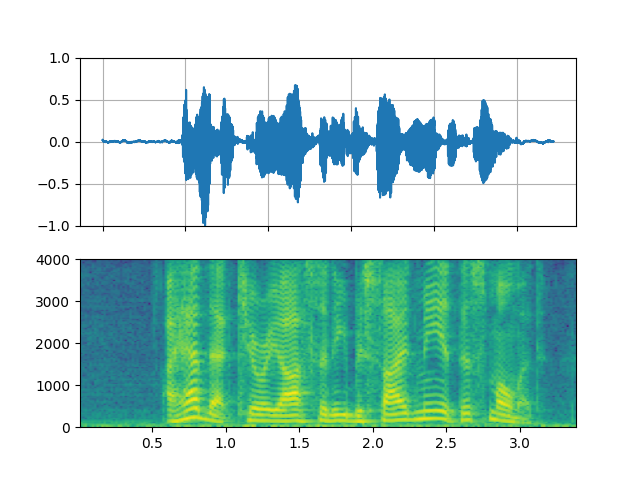注意
单击此处下载完整的示例代码
媒体流 API - 第 2 部分¶
本教程是媒体流 API - Pt.1 的延续。
这演示如何将 StreamReader 用于
设备输入,例如麦克风、网络摄像头和屏幕录制
生成合成音频/视频
使用自定义筛选条件表达式应用预处理
import torch
import torchaudio
print(torch.__version__)
print(torchaudio.__version__)
外:
1.12.0
0.12.0
try:
from torchaudio.io import StreamReader
except ModuleNotFoundError:
try:
import google.colab
print(
"""
To enable running this notebook in Google Colab, install nightly
torch and torchaudio builds and the requisite third party libraries by
adding the following code block to the top of the notebook before running it:
!pip3 uninstall -y torch torchvision torchaudio
!pip3 install --pre torch torchaudio --extra-index-url https://download.pytorch.org/whl/nightly/cpu
!add-apt-repository -y ppa:savoury1/ffmpeg4
!apt-get -qq install -y ffmpeg
"""
)
except ModuleNotFoundError:
pass
raise
import IPython
import matplotlib.pyplot as plt
base_url = "https://download.pytorch.org/torchaudio/tutorial-assets"
AUDIO_URL = f"{base_url}/Lab41-SRI-VOiCES-src-sp0307-ch127535-sg0042.wav"
VIDEO_URL = f"{base_url}/stream-api/NASAs_Most_Scientifically_Complex_Space_Observatory_Requires_Precision-MP4.mp4"
音频/视频设备输入¶
鉴于系统具有适当的媒体设备,并且 libavdevice 是 配置为使用设备,流式处理 API 可以 从这些设备中提取媒体流。
为此,我们将额外的参数传递给构造函数。 指定 Device 组件,而 Dictionary 特定于指定的组件。formatoptionformatoption
要传递的确切参数取决于系统配置。 有关详细信息,请参阅 https://ffmpeg.org/ffmpeg-devices.html。
以下示例说明了如何在 MacBook Pro 上执行此作。
首先,我们需要检查可用的设备。
$ ffmpeg -f avfoundation -list_devices true -i ""
[AVFoundation indev @ 0x143f04e50] AVFoundation video devices:
[AVFoundation indev @ 0x143f04e50] [0] FaceTime HD Camera
[AVFoundation indev @ 0x143f04e50] [1] Capture screen 0
[AVFoundation indev @ 0x143f04e50] AVFoundation audio devices:
[AVFoundation indev @ 0x143f04e50] [0] MacBook Pro Microphone
我们使用 FaceTime 高清摄像头作为视频设备(索引 0),使用 MacBook Pro 麦克风作为音频设备(索引 0)。
如果我们不传递 any ,则设备使用其默认的
配置。解码器可能不支持该配置。option
>>> StreamReader(
... src="0:0", # The first 0 means `FaceTime HD Camera`, and
... # the second 0 indicates `MacBook Pro Microphone`.
... format="avfoundation",
... )
[avfoundation @ 0x125d4fe00] Selected framerate (29.970030) is not supported by the device.
[avfoundation @ 0x125d4fe00] Supported modes:
[avfoundation @ 0x125d4fe00] 1280x720@[1.000000 30.000000]fps
[avfoundation @ 0x125d4fe00] 640x480@[1.000000 30.000000]fps
Traceback (most recent call last):
File "<stdin>", line 1, in <module>
...
RuntimeError: Failed to open the input: 0:0
通过提供 ,我们可以更改设备的格式
流转换为 Decoder 支持的格式。option
>>> streamer = StreamReader(
... src="0:0",
... format="avfoundation",
... option={"framerate": "30", "pixel_format": "bgr0"},
... )
>>> for i in range(streamer.num_src_streams):
... print(streamer.get_src_stream_info(i))
SourceVideoStream(media_type='video', codec='rawvideo', codec_long_name='raw video', format='bgr0', bit_rate=0, width=640, height=480, frame_rate=30.0)
SourceAudioStream(media_type='audio', codec='pcm_f32le', codec_long_name='PCM 32-bit floating point little-endian', format='flt', bit_rate=3072000, sample_rate=48000.0, num_channels=2)
合成源流¶
作为设备集成的一部分,ffmpeg 提供了一个 “虚拟设备” 接口。此接口提供合成音频/视频数据 生成。
为此,我们设置并提供过滤器描述
自。format=lavfisrc
过滤器描述的详细信息可以在 https://ffmpeg.org/ffmpeg-filters.html 中找到
音频示例¶
正弦波¶
https://ffmpeg.org/ffmpeg-filters.html#sine
StreamReader(src="sine=sample_rate=8000:frequency=360", format="lavfi")
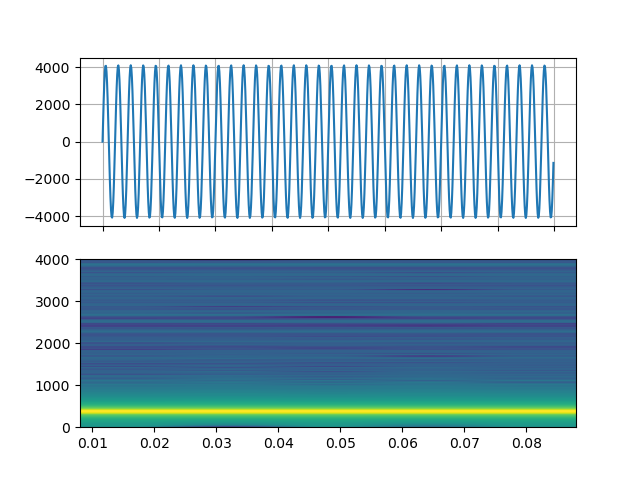
具有任意表达式的信号¶
https://ffmpeg.org/ffmpeg-filters.html#aevalsrc
# 5 Hz binaural beats on a 360 Hz carrier
StreamReader(
src=(
'aevalsrc='
'sample_rate=8000:'
'exprs=0.1*sin(2*PI*(360-5/2)*t)|0.1*sin(2*PI*(360+5/2)*t)'
),
format='lavfi',
)
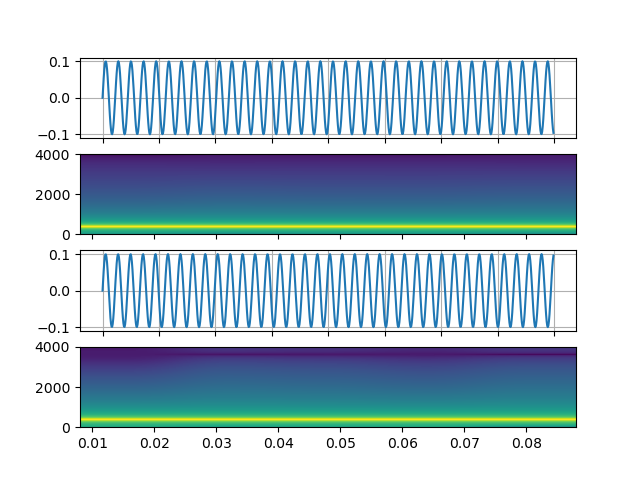
噪声¶
https://ffmpeg.org/ffmpeg-filters.html#anoisesrc
StreamReader(src="anoisesrc=color=pink:sample_rate=8000:amplitude=0.5", format="lavfi")
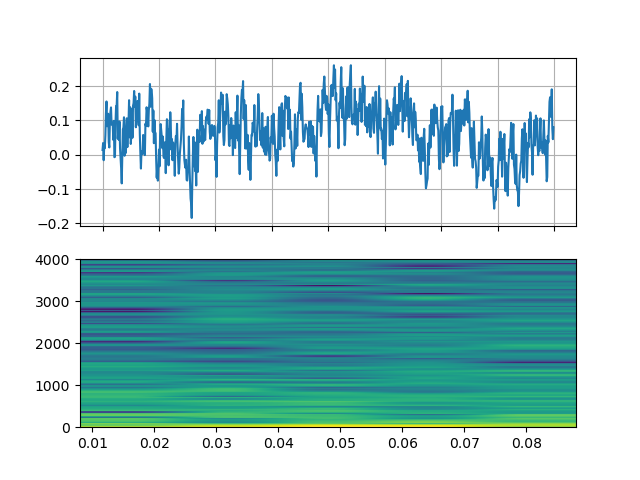
视频示例¶
元胞自动机¶
https://ffmpeg.org/ffmpeg-filters.html#cellauto
StreamReader(src=f"cellauto", format="lavfi")
曼德布洛特¶
https://ffmpeg.org/ffmpeg-filters.html#cellauto
StreamReader(src=f"mandelbrot", format="lavfi")
MPlayer 测试模式¶
https://ffmpeg.org/ffmpeg-filters.html#mptestsrc
StreamReader(src=f"mptestsrc", format="lavfi")
谢尔宾斯基地毯/三角形分形¶
https://ffmpeg.org/ffmpeg-filters.html#sierpinski
StreamReader(src=f"sierpinski", format="lavfi")
自定义过滤器¶
定义输出流时,您可以使用add_audio_stream()和add_video_stream()方法。
这些方法接受 argument,它是一个字符串
根据 FFMPEG 的 Filter 表达式进行格式设置。filter_desc
和 之间的区别在于,它构造筛选表达式并将其传递给相同的底层
实现。一切都可以
通过 实现。add_basic_(audio|video)_streamadd_(audio|video)_streamadd_basic_(audio|video)_streamadd_basic_(audio|video)_streamadd_(audio|video)_stream
注意
应用自定义筛选条件时,客户端代码必须转换 音频/视频流为 TorchAudio 可以转换为 Tensor 格式。 例如,这可以通过应用于视频流和音频流来实现。
format=pix_fmts=rgb24aformat=sample_fmts=fltp每个输出流都有单独的筛选器图。因此,它是 不能对 filter 表达式。但是,可以拆分一个输入 流式传输到多个 Film,并在以后合并它们。
音频示例¶
# fmt: off
descs = [
# No filtering
"anull",
# Apply a highpass filter then a lowpass filter
"highpass=f=200,lowpass=f=1000",
# Manipulate spectrogram
(
"afftfilt="
"real='hypot(re,im)*sin(0)':"
"imag='hypot(re,im)*cos(0)':"
"win_size=512:"
"overlap=0.75"
),
# Manipulate spectrogram
(
"afftfilt="
"real='hypot(re,im)*cos((random(0)*2-1)*2*3.14)':"
"imag='hypot(re,im)*sin((random(1)*2-1)*2*3.14)':"
"win_size=128:"
"overlap=0.8"
),
]
# fmt: on
sample_rate = 8000
streamer = StreamReader(AUDIO_URL)
for desc in descs:
streamer.add_audio_stream(
frames_per_chunk=40000,
filter_desc=f"aresample={sample_rate},{desc},aformat=sample_fmts=fltp",
)
chunks = next(streamer.stream())
def _display(i):
print("filter_desc:", streamer.get_out_stream_info(i).filter_description)
_, axs = plt.subplots(2, 1)
waveform = chunks[i][:, 0]
axs[0].plot(waveform)
axs[0].grid(True)
axs[0].set_ylim([-1, 1])
plt.setp(axs[0].get_xticklabels(), visible=False)
axs[1].specgram(waveform, Fs=sample_rate)
return IPython.display.Audio(chunks[i].T, rate=sample_rate)
高通/低通滤波器¶
_display(1)
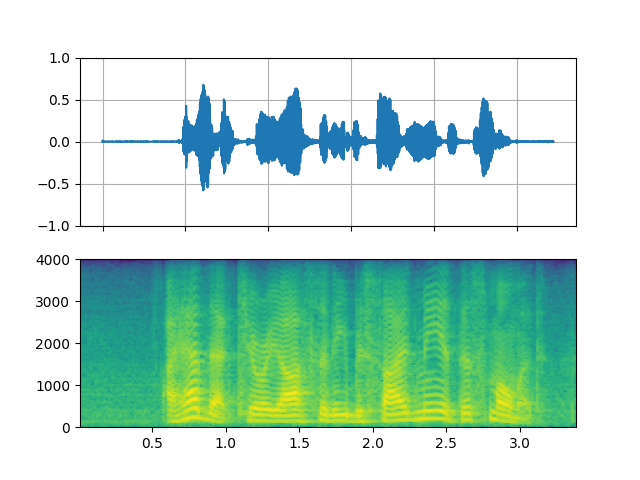
外:
filter_desc: aresample=8000,highpass=f=200,lowpass=f=1000,aformat=sample_fmts=fltp
FFT 滤波器 - 机器人 🤖¶
_display(2)
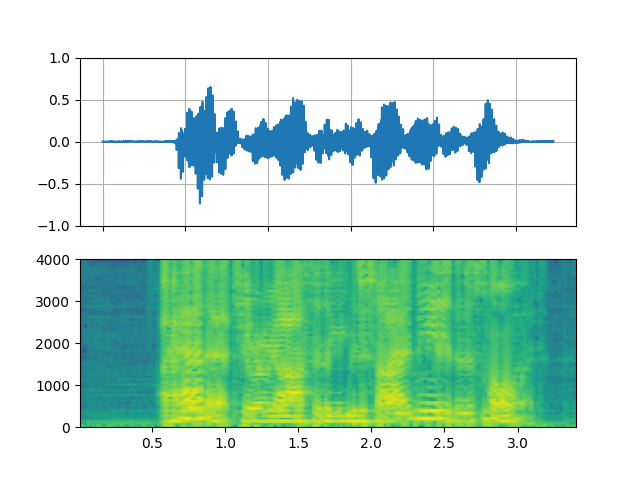
外:
filter_desc: aresample=8000,afftfilt=real='hypot(re,im)*sin(0)':imag='hypot(re,im)*cos(0)':win_size=512:overlap=0.75,aformat=sample_fmts=fltp
FFT 滤波器 - Whisper¶
_display(3)
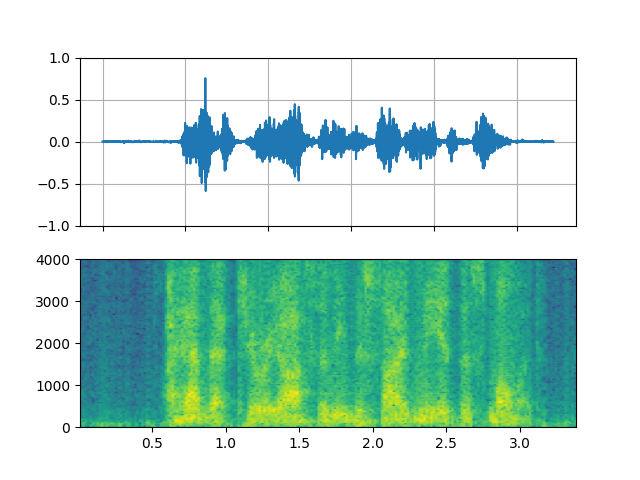
外:
filter_desc: aresample=8000,afftfilt=real='hypot(re,im)*cos((random(0)*2-1)*2*3.14)':imag='hypot(re,im)*sin((random(1)*2-1)*2*3.14)':win_size=128:overlap=0.8,aformat=sample_fmts=fltp
视频示例¶
# fmt: off
descs = [
# No effect
"null",
# Split the input stream and apply horizontal flip to the right half.
(
"split [main][tmp];"
"[tmp] crop=iw/2:ih:0:0, hflip [flip];"
"[main][flip] overlay=W/2:0"
),
# Edge detection
"edgedetect=mode=canny",
# Rotate image by randomly and fill the background with brown
"rotate=angle=-random(1)*PI:fillcolor=brown",
# Manipulate pixel values based on the coordinate
"geq=r='X/W*r(X,Y)':g='(1-X/W)*g(X,Y)':b='(H-Y)/H*b(X,Y)'"
]
# fmt: on
streamer = StreamReader(VIDEO_URL)
for desc in descs:
streamer.add_video_stream(
frames_per_chunk=30,
filter_desc=f"fps=10,{desc},format=pix_fmts=rgb24",
)
streamer.seek(12)
chunks = next(streamer.stream())
def _display(i):
print("filter_desc:", streamer.get_out_stream_info(i).filter_description)
_, axs = plt.subplots(1, 3, figsize=(8, 1.9))
chunk = chunks[i]
for j in range(3):
axs[j].imshow(chunk[10 * j + 1].permute(1, 2, 0))
axs[j].set_axis_off()
plt.tight_layout()
plt.show(block=False)
镜子¶
_display(1)

外:
filter_desc: fps=10,split [main][tmp];[tmp] crop=iw/2:ih:0:0, hflip [flip];[main][flip] overlay=W/2:0,format=pix_fmts=rgb24
随机旋转¶
_display(3)

外:
filter_desc: fps=10,rotate=angle=-random(1)*PI:fillcolor=brown,format=pix_fmts=rgb24
像素作¶
_display(4)

外:
filter_desc: fps=10,geq=r='X/W*r(X,Y)':g='(1-X/W)*g(X,Y)':b='(H-Y)/H*b(X,Y)',format=pix_fmts=rgb24
脚本总运行时间:(0 分 10.591 秒)
